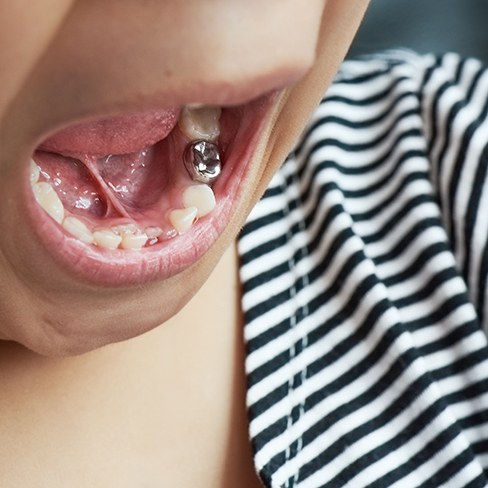Minimally Invasive Pediatric Dental Procedures Towson
Preserving Your Child’s Natural Smile
A child’s smile is constantly changing, developing, and growing. As a result, their teeth and gums need exceptional care to ensure everything remains as healthy as possible. At Kids Dental Space, we believe in providing minimally invasive procedures to protect against dental caries in addition to preserving and repairing damaged teeth so that more aggressive treatment is not required in the future. Call us today to learn more about our approach to children’s dentistry and these minimally invasive procedures.
Why Choose Kids Dental Space for Minimally Invasive Procedures?
- We Welcome Your Dental Insurance
- Your Child’s Safety is Our Priority
- Dental Emergency Appointments Available
Hall Technique

If your child’s baby teeth are suffering from severe decay, or their tooth enamel is soft and discolored from hypomineralization, we can use the Hall Technique. This method uses glass ionomer cement and a stainless steel crown to arrest (stop spreading) a dental cavity located in a primary molar. By using the Hall Technique, there is no need for tooth preparation or the removal of the cavity. Instead, we can avoid removing any of the tooth structure and still provide effective protection.
Who’s a Good Candidate for the Hall Technique?

Knowing whether your child is a good candidate for the Hall Technique requires a consultation with Dr. Roxanne. It is during this visit that we will evaluate your child and determine if they:
- Have decay forming on one or more of their primary teeth
- Have permanent molars that have recently erupted but suffer from enamel defects (i.e., discoloration that appears yellow, brown, or white)
- Have a dentin between the cavity and the pulp that is viewable on an X-ray
- Have reversible pulpitis, which is inflammation of the inner pulp (the area where various blood vessels and nerves reside)
Hall Technique Process
To perform the Hall Technique on your child, Dr. Roxanne will begin by placing spacers or “orthodontic separators” on the sides of the affected tooth. This will create the necessary space over a few days so that the procedure can be completed successfully. She will then remove the separators during a second appointment before cleaning the tooth and preparing it for treatment.
Once it is ready, she will choose an appropriately sized stainless steel crown and make necessary adjustments to it so that it fits snugly once it is placed over the tooth. The next step will be to fill the crown with a glass ionomer or resin glass ionomer cement before seating the crown over the tooth and applying firm pressure.
After cleaning off any excess cement, she will spray the inside of their mouth with water before suctioning it out and flossing around the tooth.
Benefits of the Hall Technique
Agreeing to have your child treated with the Hall Techniques comes with many great benefits, such as:
- It is a minimally invasive approach that carries minimal risk.
- It requires no anesthesia, drilling, or structural removal of decayed tissue.
- It delivers a more comfortable experience for anxious children.
- It provides long-lasting protection until it’s time for the primary tooth to fall out on its own.
- It stops the progression of the cavity and preserves the natural structure of the tooth.
- It is quick and easy to perform, so your child spends less time in the treatment chair.
Anterior Crowns

Dental cavities that form toward the front of your child’s smile need the same level of high-quality care as those that exist toward the back of the mouth. However, to ensure a more aesthetically pleasing approach, we can use tooth-colored anterior crowns that provide a more lifelike appearance. By using this type of material, your child’s tooth will be protected by a durable restoration that mimics the light-reflecting capabilities of natural enamel.
Strip Crowns

Another option should a cavity form on your child’s front tooth is to place a strip crown. Using composite resin, which is a mixture of plastic and glass powder components, we can apply it directly onto the surface of the tooth and mold the material in place. It will be shaded beforehand to ensure an appropriate match, and a specialized bonding agent will be applied to the tooth to ensure the composite adheres to the surface. A curing light is then used to harden the resin in place so that it remains durable and long-lasting.

